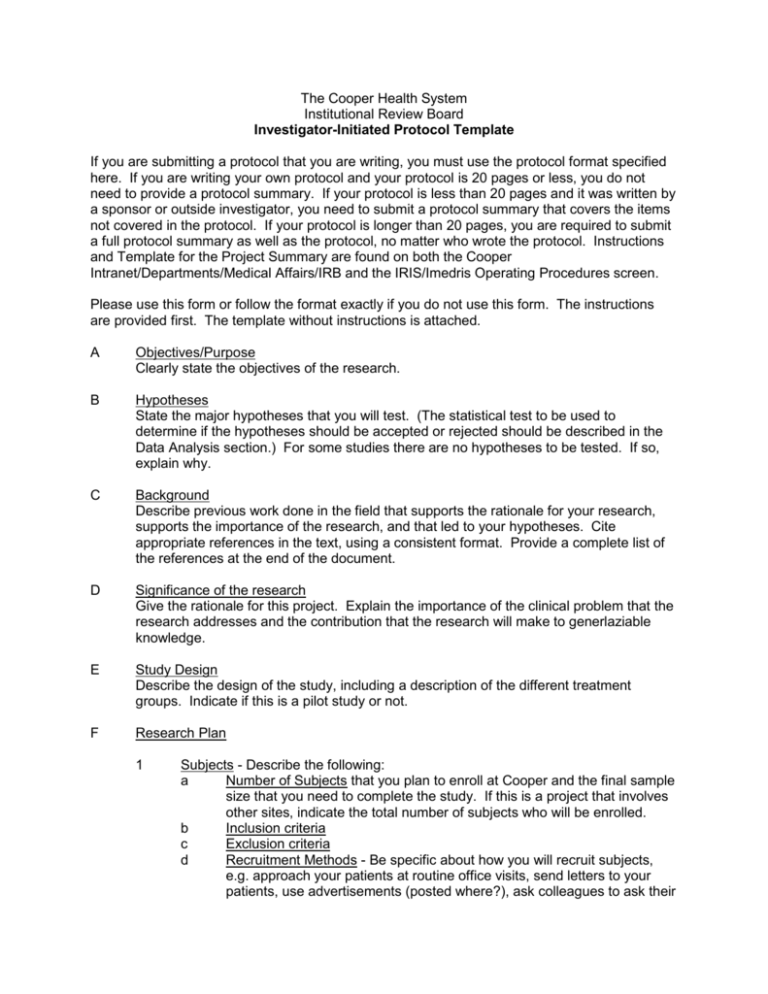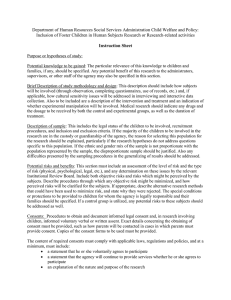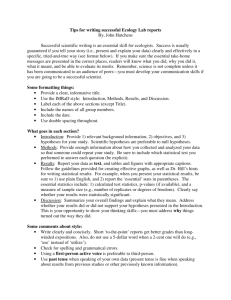Cooper Health System Protocol Template
advertisement

The Cooper Health System Institutional Review Board Investigator-Initiated Protocol Template If you are submitting a protocol that you are writing, you must use the protocol format specified here. If you are writing your own protocol and your protocol is 20 pages or less, you do not need to provide a protocol summary. If your protocol is less than 20 pages and it was written by a sponsor or outside investigator, you need to submit a protocol summary that covers the items not covered in the protocol. If your protocol is longer than 20 pages, you are required to submit a full protocol summary as well as the protocol, no matter who wrote the protocol. Instructions and Template for the Project Summary are found on both the Cooper Intranet/Departments/Medical Affairs/IRB and the IRIS/Imedris Operating Procedures screen. Please use this form or follow the format exactly if you do not use this form. The instructions are provided first. The template without instructions is attached. A Objectives/Purpose Clearly state the objectives of the research. B Hypotheses State the major hypotheses that you will test. (The statistical test to be used to determine if the hypotheses should be accepted or rejected should be described in the Data Analysis section.) For some studies there are no hypotheses to be tested. If so, explain why. C Background Describe previous work done in the field that supports the rationale for your research, supports the importance of the research, and that led to your hypotheses. Cite appropriate references in the text, using a consistent format. Provide a complete list of the references at the end of the document. D Significance of the research Give the rationale for this project. Explain the importance of the clinical problem that the research addresses and the contribution that the research will make to generlaziable knowledge. E Study Design Describe the design of the study, including a description of the different treatment groups. Indicate if this is a pilot study or not. F Research Plan 1 Subjects - Describe the following: a Number of Subjects that you plan to enroll at Cooper and the final sample size that you need to complete the study. If this is a project that involves other sites, indicate the total number of subjects who will be enrolled. b Inclusion criteria c Exclusion criteria d Recruitment Methods - Be specific about how you will recruit subjects, e.g. approach your patients at routine office visits, send letters to your patients, use advertisements (posted where?), ask colleagues to ask their e f g h G patients if they are interested in learning about your study. The text of all advertisements (radio, TV, newspaper, flyers, etc.) must be submitted to the IRB for approval before use. Informed Consent Process - Describe who will describe the study to prospective subjects under what circumstances, who will obtain informed consent and the setting, addressing how the circumstances provide the prospective subjects sufficient opportunity to consider whether or not to participate and how the circumstances minimize the possibility of coercion or undue influence. Vulnerable Subjects - Indicate if the subject population includes vulnerable subjects (prisoners. pregnant women, children, economically disadvantaged, seriously or terminally ill, decisionally impaired). Compensation to Subjects - Describe any financial or other compensation to subjects such as free medications and/or services or money for their time and travel. Be sure to include this information in the consent document as well. Treatment for Research-Related Injuries - Who will provide treatment for research-related injuries and if there are provisions to pay for such treatment, who will pay for the treatment? Be sure that this information is consistent with the contract and be sure to include this information in the consent document. 2 Research Methods and Procedures – a General description of methods and procedures. Describe the methods and procedures that will be used to carry out the study. Include dosing of study drugs and other details of study drug administration and study treatments. Identify any procedures that are experimental. b Summary of Visits and Procedures. c Procedures Just for Research Purposes. List and briefly describe all of the tests and procedures that would not be done if the subjects were not in the study. d How Participation Differs from Standard-of-Care. Explain how subjects’ participation in the research differs from the standard-of-care. e Study Duration. State the duration of the study for individual subjects and the total duration of the project. 3 Data Analysis Plan, Statistical Tests, and Sample Size Rationale - What are your outcome measures and how will they be analyzed? What statistical tests will be used to test your major hypotheses? Give your rationale for determining the number of subjects that you will need. If a sample size/power calculation is appropriate, explain how you did this. I.e., indicate the size of the difference between treatment groups that you would find meaningful, your estimate of the variability, the level of significance, whether you will use a one-sided or two-sided hypothesis test, and the power that you used to calculate the sample size. Risks and Benefits 1 Potential Risks due to Study participation - Describe potential adverse effects that subjects may experience due to study treatments and procedures. This includes the risks of standard tests that are being done solely for research purposes. H 2 Minimizing Risks - Explain how risks to subjects will be minimized by the study design, by using procedures that would be used anyway for clinical purposes, etc. 2 Potential Benefits - Describe potential benefits to individual subjects from study participation. Describe potential benefits to society from the knowledge to be gained from the research. 3 Risk:Benefit Ratio - Explain why you think the risks to subjects are reasonable in relation to benefits to individual subjects or to society. Plans for Monitoring Subject Safety Describe your plans for monitoring adverse events during the course of the study. Say if there will be a Data and Safety Monitoring Board. I Procedures to Maintain Privacy and Confidentiality Explain how you will maintain subjects= privacy and the confidentiality of data collected for research purposes. E.g. will you use only subject numbers on data sheets or in your data base and keep the code for subject names and identifying information in a separate locked cabinet? Will data be stored in locked cabinets? Who will have access to the data? Are any of the data particularly sensitive, e.g. HIV status or genetic information and are there any additional safeguards to maintain the confidentiality of sensitive data? J References Give the complete list of references that are cited in the text.









